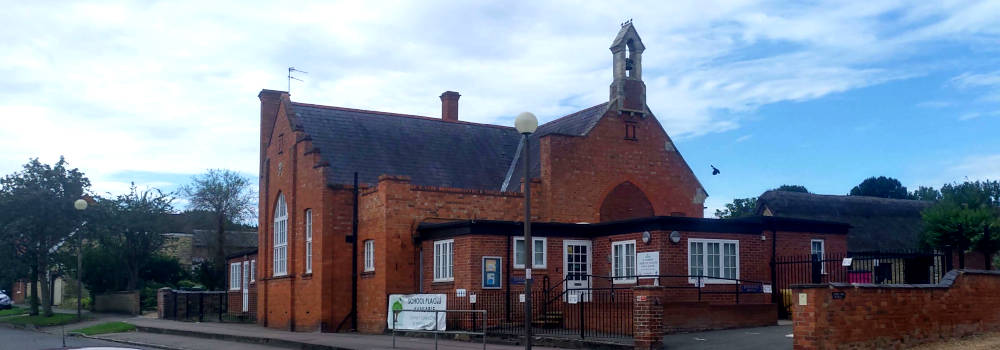St Andrew's School on Great Linford High Street
It was some few years after the passing of the 1870 Elementary Education Act that Great Linford at last saw the bureaucratic foundations laid for a new school. A final notice placed in newspapers in May of 1874 declared that the Great Linford school district was lacking any “efficient school” and that the building of a suitable school for up to 85 children must be complete no later than six months from the date of the notice.
Building the school
The local worthies acted quickly to carry out their duties, with a school planned and built in approximately the six months demanded of them. The present-day appearance of St Andrew’s school on Great Linford High Street is however the result of several distinct phases of construction, the first part of which was opened to pupils in 1875 at a cost of £500. It was partly paid for by the Reverend William Andrewes Uthwatt and designed to accommodate up to 90 children. We know from newspaper accounts that the builders were James Bird (and possibly his son Henry) of Great Linford, who lived just a few short steps away on the opposite side of the High Street, and a Mr Revitt. The name Revitt, also spelt Rivett (and other vexing variations) is one synonymous with Great Linford, as there is still a Revitt’s Cottage standing off to one side of the High Street adjacent to land known for many years as Revitt’s Yard. The Mr Revitt of Newport Pagnell is almost certainly John Holman Revitt, born Great Linford in 1841 and the son of William Samuel Revitt of Revitt’s Cottage, himself a builder and mason.
An opening celebration
An article that appeared in the Buckingham Express of Saturday January 23rd, 1875 gives an account of a gathering to celebrate the completion of the school room that drew, “the elite of the village and the locality” and was also intended to raise funds for the purchase of a Harmonium, a keyboard instrument much like an organ. The article gives an interesting and detailed description of the various songs and skits preformed during the evening, including a pianoforte duet by Miss Baily and Miss Powell, readings, and a number of comic songs including, “The Hammersmith Bells” and “Down among the coals”. Much merriment was clearly had, though it is yet to become clear if the fund raising goal was reached.
Ups and downs
St Andrew’s operated as a Church of England “National School”, though the head teacher continued to enjoy the use of the old Alms House school as accommodation, a practice apparently continued until the 1950s. The school from the outset was divided in two, with an infants’ class and a mixed class for older students, but the big change was that the girls in the village were finally to be afforded an equal chance of an education. Luckily, the school log books have survived dating back to the very inception of the school. These were generally (but not always) written up by the so called “school correspondent”, a post filled in Great Linford’s case by the incumbent priest of the church.
The log books, other surviving documents and newspaper stories provide a rich history for the school, especially in its first few decades of operation. Not only the school, but the wider administration demanded of the 1870 Education Act was something new and novel, and it would not always be smooth sailing. Parents had to be persuaded to let their children attend rather than work, but they also had to find the few pennies demanded of them to pay for their education, such that we find entries in the log books recounting how children were sent home to fetch their fees. School funds were precarious, supplies inadequate and reference made to the coldness of the classrooms. The weather often features in the log books, with attendance depressed due to rain or snow, and outbreaks of illnesses and disease like measles and fevers also impacting on class sizes. Yet despite all this the school thrived, weathering the frequent ups and the downs, the comings and goings of teachers and the growing class sizes, that saw numbers rise from just over 50 to an average of 100 or more by the early 1900s. This necessitated the expansion of the school, with a second phase of construction completed in 1905 at a cost of £900. The school has been in continuous operation to this very day, and is one of the architectural gems of the village.
The log books, other surviving documents and newspaper stories provide a rich history for the school, especially in its first few decades of operation. Not only the school, but the wider administration demanded of the 1870 Education Act was something new and novel, and it would not always be smooth sailing. Parents had to be persuaded to let their children attend rather than work, but they also had to find the few pennies demanded of them to pay for their education, such that we find entries in the log books recounting how children were sent home to fetch their fees. School funds were precarious, supplies inadequate and reference made to the coldness of the classrooms. The weather often features in the log books, with attendance depressed due to rain or snow, and outbreaks of illnesses and disease like measles and fevers also impacting on class sizes. Yet despite all this the school thrived, weathering the frequent ups and the downs, the comings and goings of teachers and the growing class sizes, that saw numbers rise from just over 50 to an average of 100 or more by the early 1900s. This necessitated the expansion of the school, with a second phase of construction completed in 1905 at a cost of £900. The school has been in continuous operation to this very day, and is one of the architectural gems of the village.



